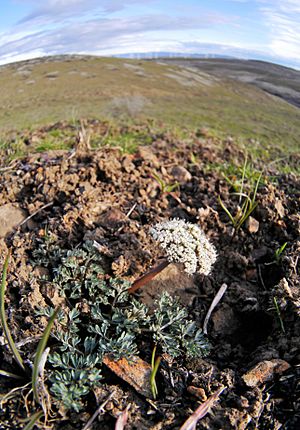Canby's biscuitroot facts for kids
Quick facts for kids Canby's biscuitroot |
|
|---|---|
 |
|
| Lomatium canbyi at Quilomene Wildlife Area near Old Vantage Highway, Kittitas County Washington | |
| Scientific classification | |
| Kingdom: | |
| (unranked): | |
| (unranked): | |
| (unranked): | |
| Order: | |
| Family: | |
| Tribe: |
Selineae
|
| Genus: | |
| Species: |
Lomatium canbyi
|
| Binomial name | |
| Lomatium canbyi J.M.Coult. & Rose
|
|
Lomatium canbyi is a type of flowering plant that belongs to the carrot family. It's often called Canby's biscuitroot. Native American tribes like the Sahaptin people call it lúukš, and the Nez Perce people call it qeqíit. This plant grows naturally in the Pacific Northwest region of the United States and in northeastern California. You can usually find it in dry, open areas covered with sagebrush or on flat, barren lands.
What Canby's Biscuitroot Looks Like
Canby's biscuitroot is a perennial herb. This means it lives for more than two years. It can grow up to about 25 centimeters (about 10 inches) tall.
- It doesn't have a main stem above the ground.
- Its leaves and flower stalks grow directly from the ground.
- The leaves can be up to 15 centimeters (about 6 inches) long.
- Each leaf is divided into many smaller, highly split leaflets.
- The plant's flowers grow in a dense, umbrella-shaped cluster. This type of flower cluster is called an umbel.
- The flowers are usually whitish in color.
How People Use Canby's Biscuitroot
The roots of the Canby's biscuitroot plant have been an important food source for some Native American peoples. The Klamath and Modoc tribes, for example, traditionally used the roots of this plant as food.

